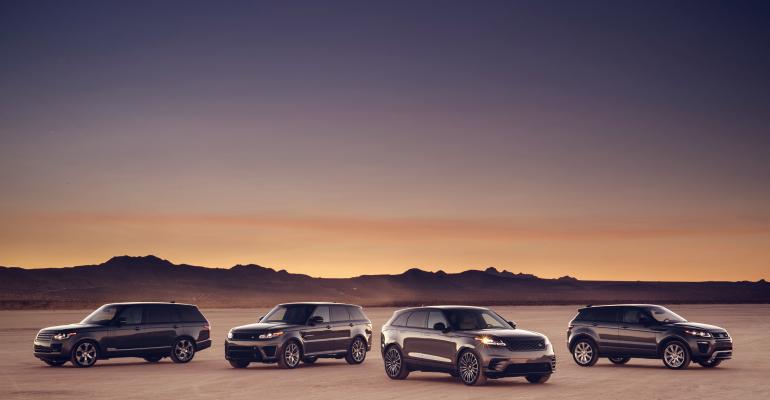As much as the Defender and Discovery are the foundations of Land Rover, the all-new Velar may be destined to achieve the same stature for Range Rover.
The ’18 Velar gives customers a premium midsize CUV option in the brand’s lineup between the compact Evoque and the pricier Range Rover Sport, a spot that Jaguar Land Rover North America President and CEO Joe Eberhardt expects will make the new model the brand’s top seller, surpassing the Range Rover Sport, which posted 21,612 deliveries last year.
“If you look at Evoque, which is one of the most successful vehicles we have in terms of attracting new customers to the brand, we actually lose some customers as they migrate up and have changes in their driving needs because the family grows…and the vehicle is not big enough,” Eberhardt observes. “And traditionally, the stretch to Range Rover Sport for some customers was just a bit too much from a price perspective.
“The Velar will slot really neatly and nicely between Evoque and Range Rover Sport, from a price and size perspective,” he says. “It will allow us to retain those customers within the Land Rover brand and within the Range Rover family. It really fills a big white space in the lineup on the Range Rover side.”
It doesn’t hurt that Velar joins the fastest-growing segment in the market – competitors include the Audi Q5, BMW X4, Mercedes-Benz GLC and Porsche Macan – while giving JLR two vehicles – the Velar and F-Pace – with distinct personalities and functional capabilities, Eberhardt adds.
“It gives us a very good one-two punch in that extremely important segment,” he says. “The F-Pace is more on-road-oriented and more dynamic, while the Velar is very much focused on design and off-road capabilities.”

“It is ‘reductionistic’ in its design, where you only focus on the lines and the elements that are really essential. As a result, it is incredibly modern in its interpretation of what a Range Rover can look like.”
The Velar arrives as Land Rover continues its global sales onslaught, growing its portfolio from five models and 144,000 deliveries in 2009 when JLR was purchased by India’s Tata, to six models and 403,000 sales in 2016.
North America played a big role in that increase, with sales jumping from a mere 28,744 to 83,850 in same period, according to WardsAuto data, including a record 73,861 U.S. deliveries.
Globally, JLR has recorded seven consecutive years of growth, up from 196,226 in 2009. The brand posted 583,000 deliveries in 2016, up 20% year-over-year.
The luxury automaker isn’t slowing its pace either, starting with the U.S. launch this year of the XF Sportbrake, a dynamic and stylish Jaguar interpretation of a wagon.
“We know that segment has not developed very positively in the U.S., so therefore we won’t have big volume aspirations for the Sportbrake,” Eberhardt says. “But we believe it’s an important part of the portfolio, and it just goes to show and demonstrate what Jaguar is capable of bringing to market and what our interpretation of a functional vehicle in a sporty shape looks like.”
Following the Sportbrake is the E-Pace compact CUV, due late this year, and then the company’s electrification push begins with the mid-2018 debut of the I-Pace battery-electric vehicle. JLR plans to incorporate some level of electrification into all its vehicles by 2020.
“The I-Pace is truly exciting because Jaguar will be first to market with a full battery-electric vehicle in a mainstream luxury brand,” Eberhardt says.
Somewhere on the horizon is the return of the legendary Defender, with the next-generation model designed for global sales, including the U.S. Eberhardt says JLR is well-positioned thanks to its growing portfolio of vehicles and wide powertrain options.
“You have to be prepared with any possible technology and powertrain combination and offer consumers that choice, so that you can react quickly to where the market will fall,” he says.
“We believe there will be internal-combustion engines for the foreseeable future. We still believe clean diesels have a very strong future. And then you have all forms of electrification.”
[email protected] @bobgritzinger





